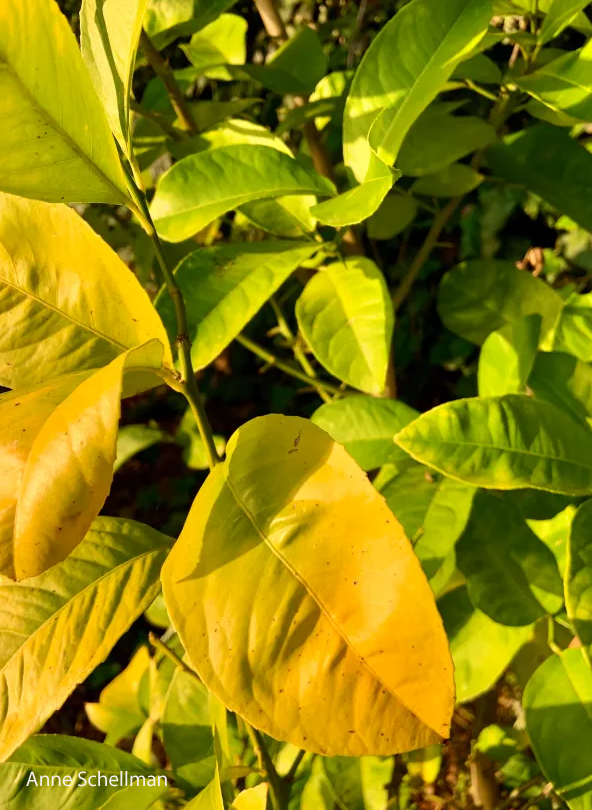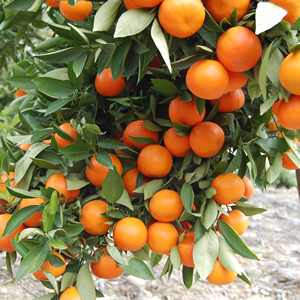Feed Your Citrus Trees

By Suzanne Mullins
The Hotline receives frequent queries regarding Citrus tree leaves. “I fertilize my orange tree but, the leaves are not totally green. What is wrong with my tree? What is up the yellow leaves on my grapefruit tree? Why are the leaves on all my lemon trees patterned with light green and yellow?”
The answer is often not “too much or too little water,” although it can be. The broad answer is fertilize & feed your trees. The complete answer is to fertilize using more nitrogen (N) than the other macronutrients, phosphorus (P) & potassium (K). Sources of Nitrogen are in 78% of the the earth’s atmosphere (air we breathe). Recent UC Davis research* revealed that up to 26% of the nitrogen in natural ecosystems (soil) originates from rock weathering.
 According to a UC IPM Citrus Cultivation note, “a mature (foliage diameter 15’-20’) grapefruit, orange, or lemon tree needs a total of 1lbs of nitrogen annually, with applications 2 or 3 times a year”. When using a commercial nitrogen product, read the label completely to know what form of nitrogen is in the bag/bottle. Without knowing what type of nitrogen, you run the risk of not giving your trees the UC IPM recommended amount of nitrogen they need. The guide below will help you to decide how much nitrogen is needed in your garden.
According to a UC IPM Citrus Cultivation note, “a mature (foliage diameter 15’-20’) grapefruit, orange, or lemon tree needs a total of 1lbs of nitrogen annually, with applications 2 or 3 times a year”. When using a commercial nitrogen product, read the label completely to know what form of nitrogen is in the bag/bottle. Without knowing what type of nitrogen, you run the risk of not giving your trees the UC IPM recommended amount of nitrogen they need. The guide below will help you to decide how much nitrogen is needed in your garden.
- Urea 46% nitrogen or 2 pounds
- Ammonium nitrate 33% or 3 pounds
- Ammonium sulfate 20% or 5 pounds
- Organic Nitrogen
- Dairy Manure 33% or 3 pounds
- Alfalfa Meal 17% or 5.8 pounds
- Poultry Manure* .05%-.09% nitrogen (60%-70% uric acid)
The Master Gardener Handbook also points out, avoid fertilizing grapefruit & orange trees in the Summer/Fall as it lowers the juice content, contributes to thicker rind, and regreens mature Valencia oranges.
 Micronutrients
Micronutrients
UC IPM states “Plants require certain mineral elements for healthy growth. Deficiencies reduce shoot growth and leaf size and cause foliage to discolor, fade, and distort, sometimes in a characteristic pattern that can help you identify the cause. Fewer leaves, flowers, and fruit may be produced.”
So, when your citrus tree presents leaves that are not a solid green, your soil might be lacking key micronutrients like zinc, iron, magnesium, manganese, and boron.
Symptoms associated with specific deficient micronutrients:
- Zinc deficient foliage causes yellow mottling between the large leaf veins.
- Iron deficient leaves gradually turn from green to yellow with veins remaining green. In cases where the deficiency is severe, new leaves are completely yellow or yellow-white.
- With magnesium deficiency, older leaves turn yellow between the veins and drop off.
- Although hard to determine, lack of manganese will present in young leaves as light green between the veins. Manganese deficiency may occur in conjunction with zinc & iron deficiencies.
- Excess boron can cause leaf tips & margins to turn yellow and then brown. Lemons and grapefruit are more susceptible sensitive than oranges. A cause of excess boron could be your irrigation water. More than 5 ppm is too much boron. Short of having a water analysis, try working bone meal (calcium/phosphorus) into your soil. Follow label directions.
After you diagnose what micronutrient you need, you can separately buy products like iron (blood meal) and magnesium (Epsom salt). Some fertilizer companies mix several micronutrients with N,P,K. too. Read the contents label for verification.
In addition, according to a Clemson University study*, poultry manure contains all 13 of the essential plant nutrients that are used by plants. These include nitrogen (N), phosphorous (P), potassium (K), calcium (Ca), magnesium (Mg), sulfur (S), manganese (Mn), copper (Cu), zinc (Zn), chlorine (Cl), boron (B), iron (Fe), and molybdenum (Mo).
Sources
- New Source of Global Nitrogen Discovered | UC Davis
- Managing Pests in Gardens: Fruit: Cultural Tips: Fertilizing citrus—UC IPM (ucanr.edu)
- Master Gardener Handbook
- Managing Pests in Gardens: Environmental Factors: Nutrient deficiencies—UC IPM (ucanr.edu)
- *Microsoft Word - pch3b_00.doc (clemson.edu)
Suzanne Mullins has been a Master Gardener since 2012

